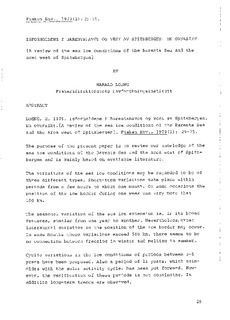Isforholdene i Barentshavet og vest av Spitsbergen. En oversikt
Research report
Permanent lenke
http://hdl.handle.net/11250/112851Utgivelsesdato
1979Metadata
Vis full innførselSamlinger
- Fisken og havet (1958- ) [700]
Sammendrag
The purpose of the present paper is to review our knowledge of the
sea ice conditions of the Barents Sea and the area west of Spitsbergen
and is mainly based on available literature.
The variations of the sea ice conditions may be regarded to be of
three different types. Short-term variations take place within
periods from a few hours to about one month. On some occasions the
position of the ice border during one week can vary more than
100 km.
The seasonal variation of the sea ice extension is, in its broad
features, similar from one year to another. Nevertheless, great
interannual variation in the position of the ice border may occur.
In some months these variations exceed 500 km. There seems to be
no connection between freezing in winter and melting in summer.
Cyclic variations in the ice conditions of periods between 3-5
years have been proposed. Also a period of 11 years, which coincides
with the solar activity cycle, has been put forward. However,
the verification of these periods is not convincing. In
addition long-term trends are observed.
The main characteristic feature of the sea ice distribution is
caused by permanent warm and cold currents in the area. There also
seems to be a connection between the heat content of the Atlantic
water which enters the Barents Sea, and the extension of the ice
in winter. How far the ice withdraws in summer depends on local
meteorological conditions only. On the west coast of Spitsbergen,
however, there appears to be a connection between extreme hydrographic
situations and extremes in distribution of ice also in the
summer.
Considering the meteorological conditions, most attention has been
focussed on the effects of air temperature, air pressure and
prevailing winds. Some authors have found corresponding variations
in air temperature and ice conditions, while others have dealt
with the relationship between air pressure differences and ice
extension. These studies indicate a correspondance between the sea
ice conditions and the atmospheric circulation. However, variations
in the atmospheric circulation also affect the intensity of
ocean currents and vice versa. This intercorrelation complicates
the task of identifying the most significant factors influencing
the variations of the sea ice.
Utgiver
HavforskningsinstituttetSerie
Fisken og havet1979-02
